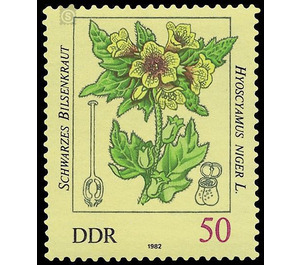poisonous plants - Germany / German Democratic Republic 1982 - 50 Pfennig
Theme: Flora
| Country | Germany / German Democratic Republic |
| Issue Date | 1982 |
| Face Value | 50.00 |
| Color | multi-colored |
| Perforation | K 14 |
| Printing Type | offset |
| Stamp Type | Postage stamp |
| Item Type | Stamp |
| Chronological Issue Number | 2438 |
| Chronological Chapter | GER-DDR |
| SID | 252340 |
| In 12 Wishlists | |
Poisonous Plants With the illustrations of poisonous plants, the Ministry of Posts and Telecommunications of the German Democratic Republic issues six multicolored special postage stamps. Special cancellation from April 6 to June 5, 1982 Poisonous plants "All things are poison, and nothing is without poison; but the dose makes that a thing is not a poison. "Theophrastus Bombastus of Hohenheim, gen. Paracelsus (1493-1541) wrote this statement in the light of the gradual transition from spice and medicinal to poisonous plants and the beneficial effects of such a plant the hand of the doctor whose uncontrolled use or misuse may be fatal.Various poisonous plants are extremely beautiful, show bright colors in flowers and fruits, or are so rare that we need to protect them.Their number is legion and in the plant world Of our native flora we have about 135 more or less poisonous plants, not counting the ornamental plants.Not all are deadly poisonous, but each affects the health considerably 50-pfennig value: Black henbane A hairy nightshade, usually two-, sometimes one-year-old (Solanaceae) with broadly serrated leaves, the flowers have a cup shaped cup, and an irregularly folded crown, which is colored a dirty yellow and pale violet stippled, wherein the Blütengrund appears dark purple. Alkaloids such as hyoscyamine, atropine, scopolamine and the like are present in all organs. contain. Their effects are general arousal, nausea, blurred vision and unconsciousness.


